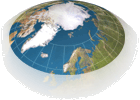 |
The Arctic As
A Homeland
Religion |
| |
All northern peoples believe that
there is a close relationship between humans and nature. Humans
and animals are said to be able to understand each other. Animals
were said to have spirits which affect the fortune of humans. Angry
spirits caused illness and benign spirits helped the hunter by guiding
animals into his path. Traditionally, the wishes of the spirits
could be found out by a spirit medium called a shaman. In a special
ritual performance, the shaman would go into a trance. It was thought
that the shaman's soul had left his or her body and flown to the
land of the spirits. Here, the shaman would try to get back the
soul of a sick person which had been captured by the spirits, or
to get the spirits to promise that the hungry community would catch
an animal. |
| |
Among some Inuit, for example, it
was said that seals were provided for humans by a spirit called
Sea-Woman who lived at the bottom of the sea. If people behaved
badly she would punish them by not allowing the seals to be caught.
Once a seal was killed, it was offered a drink of water and its
soul was returned to the sea, so that it would be re-born in the
body of a new seal. Since he had treated it with respect the previous
time, the 'same' seal would then allow itself to be killed by the
same hunter on another occasion. Even though many of these beliefs
have been modified by contact with Christianity, hunting is still
thought to depend on a mutual respect between seal and hunter, |
| |
This kind of thinking reinforces the
ideal of sharing which is vital to keeping everyone alive in this
harsh environment. Since the seal has given itself to the hunter
voluntarily, he in turn has to give a share of its meat to others.
Under a custom called in some areas nimat, it is good manners for
a hunter in Siberia who has killed an elk or other large animal to
give the entire animal to someone else. This is especially expected
of a teenager who has caught his first animal, and it is also a way
for him to prove to others that he has become a proper hunter. In
this region, though not everywhere, women as well as men can be
great hunters. |


In a workshop where sculptures based on traditional patterns are
made. |
Some of these beliefs have grown weaker
during this century under the influence of Christian missionaries,
teachers and government officials. For a long time, indigenous peoples
themselves turned their backs of these beliefs in order to appear
'modern'. But many ideas about the relationship between humans and
animals remain strong. Some Inuit in Greenland still whisper 'thank
you' to a seal they have just killed. Now, with the appalling example
of industrial society's destructive attitude to the environment
in front of them, many of the younger generation of Native peoples
are looking again at the ideas of their parents and grandparents
and often seeing them in a more favourable light. |
| Even those who can no longer believe
in spirits, often feel that there is something sacred in the landscape
and that you can feel this when you are alone face to face with
the power of the forces of nature. |
|

